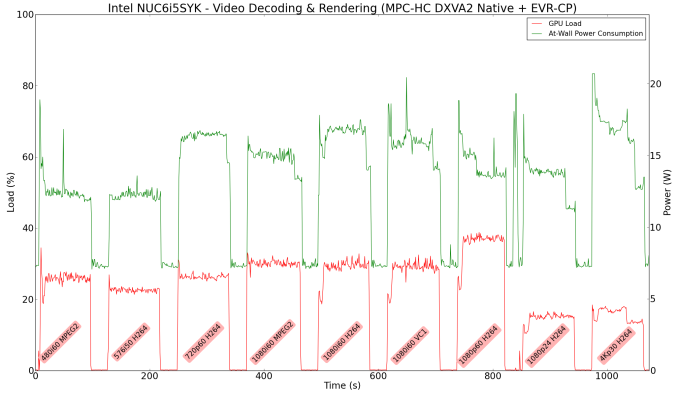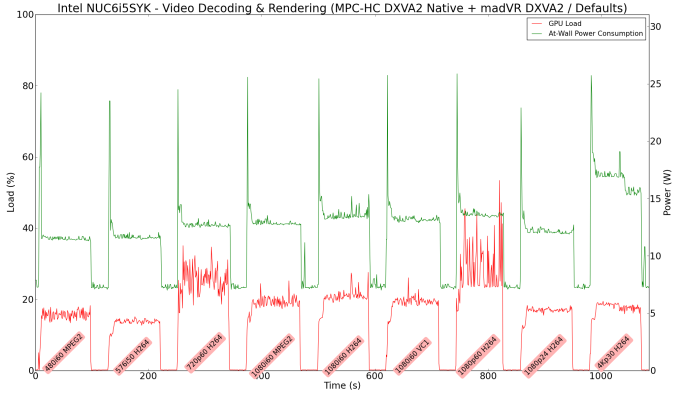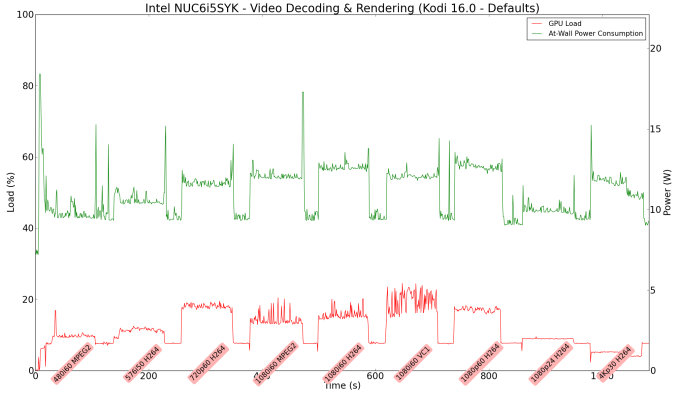The Intel NUC6i5SYK Skylake UCFF PC Review
by Ganesh T S on March 11, 2016 8:00 AM ESTHTPC Credentials
The thermal solution on the NUC6i5SYK is the same as what we have seen in the previous NUCs. Since the Core i5-6260U is a 15W TDP processor, the acoustics are pretty decent (when compared to the fans on the units with 28W TDP processors). Subjectively speaking, the unit is silent for most common HTPC use-cases. Only under heavy CPU / GPU loading (such as stressful madVR configurations) does the fan become audible. Like the previous NUCs, the NUC6i5SYK retains CIR support, enabling use of IR remotes in a home theater setting. The unit definitely makes a good HTPC for folks who don't want to pay the premium for a passively cooled system - however, we didn't find too many improvements over the previous NUCs for HTPC workloads. There is still no HDMI 2.0 / HDCP 2.2 / 4Kp60 HDMI support in the unit.
Refresh Rate Accuracy
Starting with Haswell, Intel, AMD and NVIDIA have been on par with respect to display refresh rate accuracy. The most important refresh rate for videophiles is obviously 23.976 Hz (the 23 Hz setting). As expected, the Intel NUC6i5SYK has no trouble with refreshing the display appropriately in this setting. In fact, the NUC6i5SYK has the most accurate display refresh rates of all the PCs that we have evaluated so far.
The gallery below presents some of the other refresh rates that we tested out. The first statistic in madVR's OSD indicates the display refresh rate.
Network Streaming Efficiency
Evaluation of OTT playback efficiency was done by playing back our standard YouTube test stream and five minutes from our standard Netflix test title. Using HTML5, the YouTube stream plays back a 1080p encoding. Since YouTube now defaults to HTML5 for video playback, we have stopped evaluating Adobe Flash acceleration. Note that only NVIDIA exposes GPU and VPU loads separately. Both Intel and AMD bundle the decoder load along with the GPU load. The following two graphs show the power consumption at the wall for playback of the HTML5 stream in Mozilla Firefox (v 44.0.2).

GPU load was around 24.27% for the YouTube HTML5 stream and barely measurable for the steady state 6 Mbps Netflix streaming case. Note that GPU usage reported by GPU-Z doesn't actually measure the load on the dedicated decoder engines in the GPU.
Netflix streaming evaluation was done using the Windows 10 Netflix app. Manual stream selection is available (Ctrl-Alt-Shift-S) and debug information / statistics can also be viewed (Ctrl-Alt-Shift-D). Statistics collected for the YouTube streaming experiment were also collected here.

Decoding and Rendering Benchmarks
In order to evaluate local file playback, we concentrate on EVR-CP, madVR and Kodi 16.0. We already know that EVR works quite well even with the Intel IGP for our test streams. Under madVR, we used the DXVA2 scaling logic wherever available, and left the rest at default (as it is well known that the stressful configurations don't work even on the Iris Pro-equipped processors). We used the DXVA2 native decoder in the LAV Filters bundled with MPC-HC v1.7.10
In our earlier reviews, we focused on presenting the GPU loading and power consumption at the wall in a table (with problematic streams in bold). Starting with the Broadwell NUC review, we decided to represent the GPU load and power consumption in a graph with dual Y-axes. Nine different test streams of 90 seconds each were played back with a gap of 30 seconds between each of them. The characteristics of each stream are annotated at the bottom of the graph. Note that the GPU usage is graphed in red and needs to be considered against the left axis, while the at-wall power consumption is graphed in green and needs to be considered against the right axis.
Frame drops are evident whenever the GPU load consistently stays above the 85 - 90% mark. The NUC6i5SYK has absolutely no trouble with any of our test streams. Kodi is the most power efficient of the lot, while madVR with DXVA scaling is actually quite power efficient and comparable to EVR-CP.
Moving on to the codec support, the Intel Iris Graphics 540 is a known quantity with respect to the scope of supported hardware accelerated codecs. DXVA Checker serves as a confirmation. Recent driver updates have added VP9 decode support, but, only for 8b encodes.





















95 Comments
View All Comments
Teknobug - Sunday, March 13, 2016 - link
"for external graphics"^ did you miss that?
AnnonymousCoward - Monday, March 14, 2016 - link
I read "external graphics" as a monitor. Now I guess he meant a GPU. So who exactly would want to match a 15W CPU with a discrete GPU?TheinsanegamerN - Monday, March 14, 2016 - link
Given the sales of the alienware 13, my guess would be more then you think. Most games dont need a quad core i7 to run properly.AnnonymousCoward - Monday, March 14, 2016 - link
It's true that games can run ok, but still. This cpu would likely be a big bottleneck in loading, and processing all the elements of a big game that has hundreds or thousands of moving things. VR will want more cpu. But sure, if you just wanna run CS, you can use any cpu.TheinsanegamerN - Wednesday, March 16, 2016 - link
The AW13 cn oush games like shadow of mordor with an external dock. Slower, yes, but it can still hit 50fps+.Of course, nobody who wants maximum settings would buy the NUC, but more midrange gamers would be served well. And since the skull canyon will most likely be a quad core part, CPU performance will be a moot argument,
zodiacfml - Saturday, March 12, 2016 - link
The CPU power limits are quite impressive compared to my i5-5200u. this makes its performance not far from the ECS LIVA One.Sivar - Saturday, March 12, 2016 - link
Thank you for the article.I am a little disappointed with vendors that fanless NUCs are still unavailable except as specialty parts with low-volumeish markups like Logic Supply (which makes great stuff, but not cheap).
HTPC Credentials typo: "Refresh Rate Accura[n]cy"
Zingam - Sunday, March 13, 2016 - link
$675 - and this includes the price of Win10 too?ganeshts - Sunday, March 13, 2016 - link
The configuration posted (256GB NVMe drive + Corsair 2400 MHz SODIMMs) doesn't include WIn 10 cost. However, I see now that 2133 MHz SODIMMs are available for a much lower price and, even the NVMe drive can be replaced by a much cheaper AHCI drive (IIRC, Mushkin's 256GB M.2 AHCI drive is only $85 or so - less than half the price of the NVMe Samsung drive).So, yes, it is possible to build the whole configuration along with Windows 10 for $675 (even lower is possible).
In our cost comparison tables as well as spec tables, we have never considered OS cost. So, the number quoted is consistent with our previous reviews.
twotwotwo - Monday, March 14, 2016 - link
If you go with 2x4GB DDR4, i3, and 256GB 850 EVO m.2 SSD, it's $400 (and, for the moment, there's Prime shipping on all that from Amazon). You can also opt for the taller one with the 2.5" drive slot to do the small SSD+big HDD thing. All to say, there are lots of compromises for cost short of, like, going to an older gen, a much larger box, or Atom.